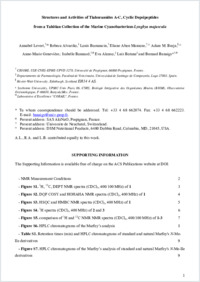Structures and activities of tiahuramides A–C, cyclic depsipeptides from a tahitian collection of the marine cyanobacterium Lyngbya majuscula
- Levert, Annabel CRIOBE, USR Université de Perpignan, France
- Alvariño, Rebeca Departamento de Farmacología, Facultad de Veterinaria, Universidad de Santiago de Compostela, Lugo Spain
- Bornancin, Louis CRIOBE, USR Université de Perpignan, France
- Abou-Mansour, Eliane CRIOBE, USR Université de Perpignan, France - Biology, Université de Fribourg, Switzerland
- Burja, Adam M. Heriot-Watt University, Edinburgh, Scotland - DSM Nutritional Products, Columbia, USA
- Genevière, Anne-Marie Biologie Intégrative des Organismes Marins (BIOM), Sorbonne Universités, Univ Paris 06, Banyuls/Mer, France
- Bonnard, Isabelle CRIOBE, USR Université de Perpignan, France - Laboratoire d?Excellence ?CORAIL?, Perpignan, France
- Alonso, Eva Departamento de Farmacología, Facultad de Veterinaria, Universidad de Santiago de Compostela, Lugo Spain
- Botana, Luis Departamento de Farmacología, Facultad de Veterinaria, Universidad de Santiago de Compostela, Lugo Spain
- Banaigs, Bernard CRIOBE, USR Université de Perpignan, France
-
22.06.2018
Published in:
- Journal of Natural Products. - 2018, vol. 81, no. 6, p. 1301–1310
English
The structures of three new cyclic depsipeptides, tiahuramides A (1), B (2), and C (3), from a French Polynesian collection of the marine cyanobacterium Lyngbya majuscula are described. The planar structures of these compounds were established by a combination of mass spectrometry and 1D and 2D NMR experiments. Absolute configurations of natural and nonproteinogenic amino acids were determined through a combination of acid hydrolysis, derivitization with Marfey’s reagent, and HPLC. The absolute configuration of hydroxy acids was confirmed by Mosher’s method. The antibacterial activities of tiahuramides against three marine bacteria were evaluated. Compound 3 was the most active compound of the series, with an MIC of 6.7 μM on one of the three tested bacteria. The three peptides inhibit the first cell division of sea urchin fertilized eggs with IC50 values in the range from 3.9 to 11 μM. Tiahuramide B (2), the most potent compound, causes cellular alteration characteristics of apoptotic cells, blebbing, DNA condensation, and fragmentation, already at the first egg cleavage. The cytotoxic activity of compounds 1–3 was tested in SH-SY5Y human neuroblastoma cells. Compounds 2 and 3 showed an IC50 of 14 and 6.0 μM, respectively, whereas compound 1 displayed no toxicity in this cell line at 100 μM. To determine the type of cell death induced by tiahuramide C (3), SH-SY5Y cells were costained with annexin V–FITC and propidium iodide and analyzed by flow cytometry. The double staining indicated that the cytotoxicity of compound 3 in this cell line is produced by necrosis.
- Faculty
- Faculté des sciences et de médecine
- Department
- Département de Biologie
- Language
-
- English
- Classification
- Biological sciences
- License
-
License undefined
- Identifiers
-
- RERO DOC 322794
- DOI 10.1021/acs.jnatprod.7b00751
- Persistent URL
- https://folia.unifr.ch/unifr/documents/307234
Other files
Statistics
Document views: 105
File downloads:
- pdf: 354
- Supplementary material: 199

